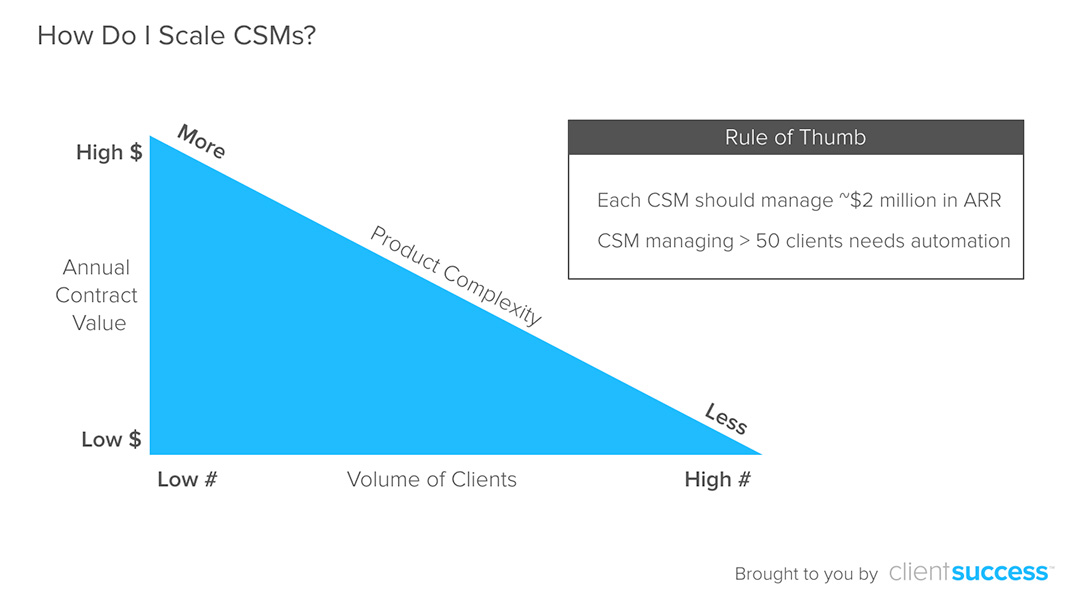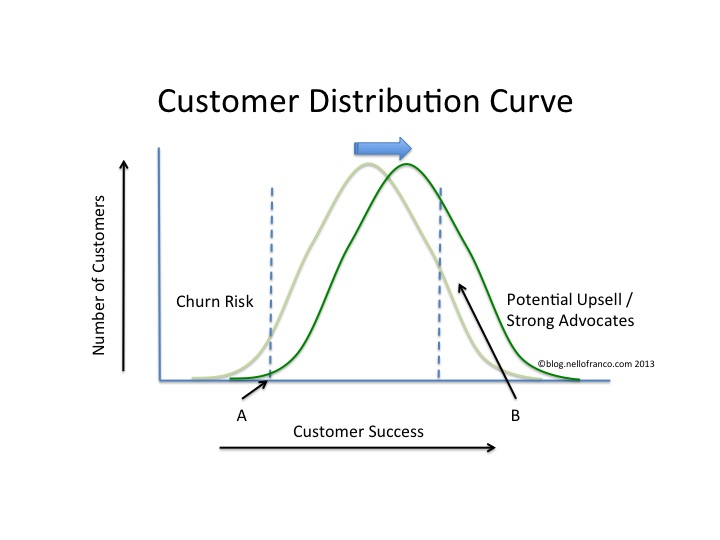
Ask any startup investor why they want to own a piece of a SaaS business and at some point you’ll hear the word “scalability.”
Scalability is what makes software companies so appealing. There’s no labor-intensive service to provide. No widget to put on shelves. Just a product to put online and logins to sell.
It sounds simple, but scaling is hard, especially for certain internal teams, like customer success.
[Tweet “Customer success is human-focused. Scaling is tricky because you lose one-to-one customer communication.”]
Customer success is human-focused. Scaling is tricky because you lose one-to-one customer communication. You’re forced to become targeted and proactive, data-minded yet flexible.
First, you have to know when to scale. Then, you need the right process, people and technology to make it work.
When to scale your customer success team
Knowing when to scale is just as important as doing it. Like everything that has to do with customer success, you want to be strategic about growth, not reactionary.
First, consider the annual contract value of each customer. It is industry standard for customer success managers (CSM) to oversee about $2 million in annual revenue across their customers. Your results may vary.
How many customers equate to $2 million/year will depend on your business. Some enterprise SaaS businesses may bring in $2 million from just a handful of customers, but each one requires more time, training, goal alignment, and time for value realization. Losing one of those customers can be financially damaging, so you don’t want your CSM overwhelmed.
If your customers are smaller, it’s possible for a CSM to manage thousands of customers. Since each customer doesn’t represent a large portion of the total revenue and likely doesn’t need much time investment, a single CSM can oversee them all. (In this case, the SaaS should use a lot of automation.)
Second, consider the complexity of your product. Generally, more complex products require more time training, configuring, and deploying across all customers, so you need more CSMs.
Salesforce, for instance, has multiple features and integrations that need to be customized for each customer, so more CSMs are needed to manage the process. Simpler technology that can be learned and used without someone’s help (such as Buffer, for example), can be managed with fewer CSMs.
Finally, consider how many customers each CSM is expected to manage. I can’t give you a hard number here because it depends on your business, your product, and your customer.
Be careful when you determine this number. It may be possible for a CSM to handle 50 accounts, but he’ll spend his entire day putting out fires. To get ahead of retention, you need to give CSMs opportunities to proactively engage with clients.
This triangle by ClientSuccess shows the relationship between the three variables.

Define these three factors carefully within your organization. Figure out how each relates to your growth. Set triggers for hiring CSMs. For example, you might decide to add a CSM when any of these triggers are set off.
- Annual contract value raises above $1.5 million.
- A new core feature is added to the product that requires in-company training.
- All current CSMs are managing 22 accounts.
Finally, you’ll want to consider some less tangible metrics. Look for signs of poor customer relationships, unexplained churn, and CSMs who report a majority of their day spent solving immediate problems instead of looking ahead.
Having a process that supports your purpose
Having a well-defined purpose is the most effective thing you can do to make your customer success team successful. Without a clear purpose, you can’t create a process that gets it done. You’ll just be spinning your wheels, doing things that don’t amount to anything.
Processes make scaling far easier because you’ll have something concrete to grow, rather than some nebulous idea of what customer success means within your organization. Clear processes mean you can quickly bring new CSMs into your workflow.
Once you have your purpose, you can create a process that achieves it. Any components of the process that don’t serve the goal should be removed.
For instance, let’s say the customer success team has the purpose of improving customer satisfaction. They would spend their time learning the basic needs of the customer and walking them down the path to value. The might use a Net Promoter score to measure their success. They wouldn’t worry about service expansions (although they would definitely share their information with whichever team was responsible for that).
Having a process isn’t enough. It has to align with your purpose. Many customer success teams operate under the illusion of control because they have day-to-day tasks documented. Yet they aren’t achieving their goals because the process doesn’t take them there.
There are three processes every customer success team needs.
1. Annual lifecycle
This is what you will do on a yearly basis for the customer. You set the target here. Do not allow the customer to dictate your goals. You understand the product best. Define three key outcomes for your customer to achieve that make renewal likely and a timeline to achieve them.
2. Onboarding
This is how you’ll get the customer from zero to realizing value. It’s more than understanding how to use the product. They need to achieve something that makes them say “I’m glad we did this.” Be careful not to overload them with information. Your process needs to state what you’ll do, who will do it, and when.
3. Quarterly Business Review
This replaces the traditional (and ineffective) check-in phone call that customers often ignore. A review reinforces the value of the product. Send a report to the client with how the product has provided them value along with your own commentary.
Make them feel like you’re a partner, not a pest. Use the conversation to define goals for next quarter and year so you have future ways to provide value.
You may require more, depending on your purpose, but those three are critical.
(Side note: Here’s an interesting read at process.st on how several SaaS companies have shaped their customer success processes.)
Hiring the right people for customer success
I’ve talked about the need to fill your customer success team with people who are built to serve. It’s critical that everyone who interacts with your customers understand the customer success purpose.
This starts with a strong customer success leader (usually vice president level, but I’ve heard of Chief Customer Officers). This person should be willing to do whatever it takes to help the customer achieve value. They should be willing to honestly look at success and failures, work closely with other teams, be comfortable talking to customers, and gleaning insights from data.
Your CSMs should be customer-focused people as well, willing to solve problems and create solutions every day. I’ve written several articles on building your customer success team, so I’ll link those.
- Are You Built to Serve? This post lists the qualities you need in CSMs.
- How to Create a High Performing Team – This post is about choosing and evaluating people on your customer success team.
- How to Discover Someone’s Natural Strengths – This post explains how to uncover what your team members are good at so you can lean on their strengths.
- Assigning Projects: Availability vs. Strength – This post explains how to delegate tasks to your team.
- The Definitive Customer Success Manager Salary Guide – This is about structuring compensation for your team.
Hiring great people who fit with the team takes time. Begin the hiring process before you need a new CSM or you’ll end up settling for a poor-fit employee.
One last thing: Scaling requires the right technology
I won’t bore you with a rambling of the importance of automated technology. You’re a SaaS business, so you already understand that. You know you need software to properly scale.
Some purists resist automation in customer success. They think it interferes with what should be a human-to-human interaction. This is common in businesses with high-touch models.
We use automation to do what we would do manually if we had the resources. We know that an automated email sequence will never be as personal as a custom-written message, but the alternative is no message at all. So we use technology to compensate.
In customer success, use automation to initiate conversations with your customers. You might have an email sent when a user hasn’t logged into the application in three days, or when their health score drops below a predefined value. If you have hundreds (or thousands) of low-touch customers, scaling requires a dedicated tool.
This graph by customer success expert Nello Franco shows how automation can be used to shift your customer distribution away from higher churn risk.

I recommend using a customer success tool (specifically one of the ones you’ll find in the next link). You could also create custom solutions for pieces of your specific process, though I recommend using an all-in-one tool for a while to see what features are available.
Need help scaling your SaaS? Contact us to learn more.
